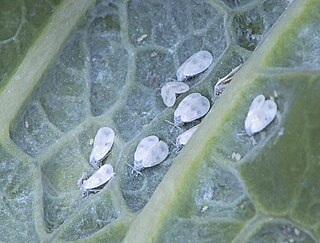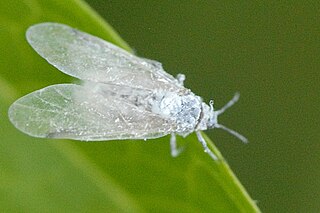
Whiteflies are Hemipterans that typically feed on the undersides of plant leaves. They comprise the family Aleyrodidae, the only family in the superfamily Aleyrodoidea. More than 1550 species have been described.

The silverleaf whitefly is one of several species of whitefly that are currently important agricultural pests. A review in 2011 concluded that the silverleaf whitefly is actually a species complex containing at least 40 morphologically indistinguishable species.

Trialeurodes is a large genus of whiteflies in the family Aleyrodidae.

The Sternorrhyncha suborder of the Hemiptera contains the aphids, whiteflies, and scale insects, groups which were traditionally included in the now-obsolete order "Homoptera". "Sternorrhyncha" refers to the rearward position of the mouthparts relative to the head.

Citrullus ecirrhosus, commonly known as Namib tsamma, is a species of perennial desert vine in the gourd family, Cucurbitaceae, and a relative of the widely consumed watermelon. It can be found in both Namibia and the Cape Provinces of South Africa, in particular the Namib Desert. It is the sister species to the bitter melon, Citrullus amarus with which it shares hard, white and bitter flesh.
Baeoentedon is a genus of hymenopteran insects of the family Eulophidae, they are parasitoids of whitefly from the family Aleyrodidae which are found on trees of the genus Ficus. They have been recorded from Australia, China, India, Indonesia and Florida. A fifth species, Baeoentodon farazi, was described from Karnataka, India, in 2017.

The cabbage whitefly is a species of whitefly from the Aleyrodidae family. It has a global distribution.

Aleyrodinae is a subfamily of whiteflies in the family Aleyrodidae.

Bemisia is a genus of whitefly in the family Aleyrodidae.

Dialeurodes is a genus of whiteflies in the family Aleyrodidae. There are at least three described species in Dialeurodes.

Encarsia is a large genus of minute parasitic wasps of the family Aphelinidae. The genus is very diverse with currently about 400 described species and worldwide distribution. The number of existing species is expected to be several times higher because many species are still undescribed. Encarsia is a very complex genus, with specimens showing both inter- and intra-specific variations, making morphological classification difficult.
Aleurodicus rugioperculatus is a species of whitefly found throughout the Florida Keys. This insect was first described by Jon H. Martin in 2004.
Encarsia inaron is a parasitoid wasp used in the control of ash whitefly, Siphoninus phillyreae. The ash whitefly is an insect from Europe that feeds on the sap of plants, and which has become a pest in North America. E. inaron was acquired from Italy and Israel and brought to California in 1989.
Aleyrodes millettiae is a whitefly species named by François Cohic in 1968.
Macrolophus caliginosus is a species of true bug in the family Miridae. It is omnivorous and both preys on insects and feeds on plant tissues. It is used in Europe in the biological control of whitefly in tomatoes grown under glass.
Florence Eugenie Bemis (1861?–?) was a late 19th and early 20th century American entomologist and expert in whiteflies.

Siphoninus phillyreae, the ash whitefly, is a species of whitefly native to western Eurasia, India and North Africa but also introduced to North America. It is known in agriculture as a pest species of fruit trees, including pomegranates, pear and apple trees. It also feeds on ash and ornamental pear trees. Encarsia inaron is used as a biological control for it.
Baeoentedon balios, the balios wasp, is a species of chalcid wasp which was first described from China in 2014. It is a parasitoid of whiteflies of the family Aleyrodidae.

Aleurothrixus floccosus, the woolly whitefly, is a species of whitefly in the family Aleyrodidae. Probably native to the Neotropics; it is found in the Nearctic, Africa and Europe.

Aleurocanthus spiniferus, the citrus spiny whitefly, is an important pest of citrus and tea plants. They are part of the order Hemiptera, and the family Aleyrodidae, where more than 1550 species have been described. A. spiniferus is indigenous to parts of tropical Asia, where it was first discovered in Japan. Since its discovery, it has now spread to numerous continents including Africa, Australia, America, Pacific Islands and Italy. Wherever it is found, it has become a highly destructive pest. Two populations of A. spiniferus have been found according to the plant or crop they infest: the citrus spiny whitefly, as well as the tea spiny whitefly.












